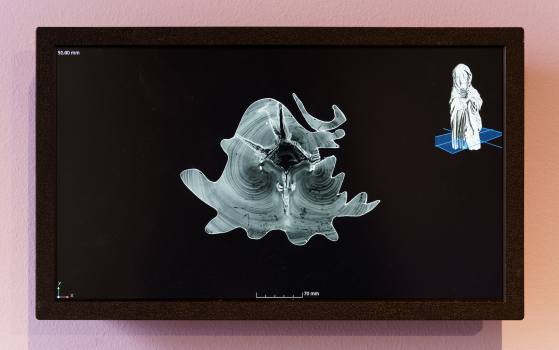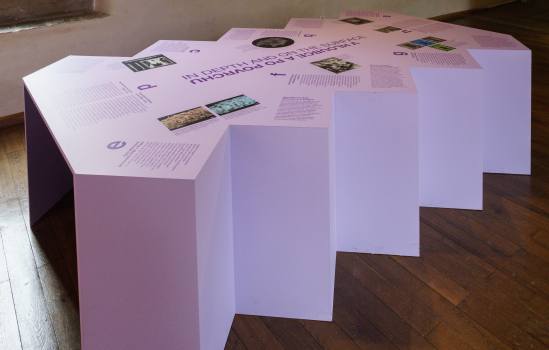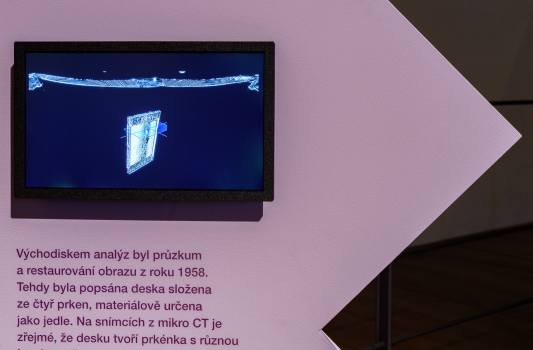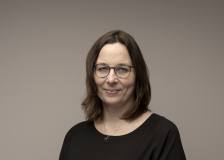The small show presents the results of a fascinating interdisciplinary
project dedicated to the method of computed tomography in the study of works of
ancient art, presented within the long-term exhibition Medieval Art in Bohemia and Central Europe 1200–1550. Many of us
have first-hand experience of medical CT scans, but what are CT scanners useful
for in art collections practice?
Tomographic imaging of an object exceeds X-ray imaging in terms of information. It provides a detailed record of the internal structure at different levels, layer by layer. For example, it is possible to record in detail the progression of damage as well as technological details such as joints or the structure of the materials used. If, for example, we want to use imaging methods to obtain data for dendrochronological dating of used wood, neither X-ray nor medical tomography equipment is usually sufficient; we need a computed tomograph with higher sensitivity and high resolution.
That is why the National Gallery Prague turned to the Institute of Theoretical and Applied Mechanics of the Czech Academy of Sciences, which works with a patented device with a resolution many times higher than that of commonly used medical tomographs. Within the framework of a grant project supported by the Ministry of Culture of the Czech Republic (NAKI II), in which the Institute of Theoretical and Applied Mechanics of the Czech Academy of Sciecnes, the Institute of Technical and Applied Physics of the Czech Technical University in Prague, and the National Gallery Prague collaborated, several sculptures and paintings were examined to verify the benefits, but also the limits of computed tomography for the study of works of ancient art.
What is the concept of this intimate exhibition? In nine stops, the visitor can learn in detail why and with what result the selected works were examined by computed tomography. Thanks to the documentation of the surveys, we can better understand what clues the work itself provides and when we have to look to modern survey methods for support. After an introduction to the topic in the opening part of the exhibition, examples of the use of this method on specific monuments of panel painting and sculpture in the exhibition space follow. The exhibition also includes an open children’s studio, inspired by the themes of artwork research in art collecting practice.
Curator: Štěpánka Chlumská
Convent of St Agnes of Bohemia – premises of the long-term exhibition Medieval Art in Bohemia and Central Europe 1200–1550
Tomographic imaging of an object exceeds X-ray imaging in terms of information. It provides a detailed record of the internal structure at different levels, layer by layer. For example, it is possible to record in detail the progression of damage as well as technological details such as joints or the structure of the materials used. If, for example, we want to use imaging methods to obtain data for dendrochronological dating of used wood, neither X-ray nor medical tomography equipment is usually sufficient; we need a computed tomograph with higher sensitivity and high resolution.
That is why the National Gallery Prague turned to the Institute of Theoretical and Applied Mechanics of the Czech Academy of Sciences, which works with a patented device with a resolution many times higher than that of commonly used medical tomographs. Within the framework of a grant project supported by the Ministry of Culture of the Czech Republic (NAKI II), in which the Institute of Theoretical and Applied Mechanics of the Czech Academy of Sciecnes, the Institute of Technical and Applied Physics of the Czech Technical University in Prague, and the National Gallery Prague collaborated, several sculptures and paintings were examined to verify the benefits, but also the limits of computed tomography for the study of works of ancient art.
What is the concept of this intimate exhibition? In nine stops, the visitor can learn in detail why and with what result the selected works were examined by computed tomography. Thanks to the documentation of the surveys, we can better understand what clues the work itself provides and when we have to look to modern survey methods for support. After an introduction to the topic in the opening part of the exhibition, examples of the use of this method on specific monuments of panel painting and sculpture in the exhibition space follow. The exhibition also includes an open children’s studio, inspired by the themes of artwork research in art collecting practice.
Curator: Štěpánka Chlumská
Convent of St Agnes of Bohemia – premises of the long-term exhibition Medieval Art in Bohemia and Central Europe 1200–1550
1—1 / 9
















